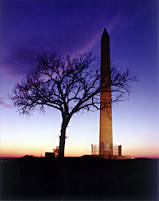Charles Floyd
 |
| This monument to Charles Floyd stands on a bluff above the Missouri outside Sioux City, IA. The sandstone obelisk is 100 feet high. Image courtesy of US Army Corps of Engineers. |
For a man whose fame came by what he was unable to accomplish with the Corps of Discovery, Charles Floyd is remembered fondly.
Floyd became the only man in the Corps to die on the Lewis and Clark expedition. Medical historians believe a ruptured appendix caused Floyd's death on Aug. 20, 1804, outside present Sioux City, IA.
"Sergeant Floyd much weaker and no better," wrote William Clark in his Aug. 20 journal entry. "Floyd as bad as he can be no pulse & nothing will stay a moment on his Stomach or bowels. Floyd Died with a great deal of Composure, before his death he Said to me, ‘I am going away I want you to write me a letter.' We buried him on top of the bluff. 1/2 Mile below a Small river to which we Gave his name, He was buried with the Honors of War much lamented, a Seeder post with the Name Sergt. C. Floyd died here 20th of august 1804 was fixed at the head of his grave."
Floyd's gravesite today has the largest, most prestigious memorial of anyone in the Corps, the captains included. A 100-foot-high obelisk made of sandstone masonry stands 200 yards from where Floyd originally was buried. This obelisk is second in size only to that of the Washington Monument. It was dedicated in 1901 and in 1960 became the first historic landmark added to the national register.
The monument marked the fourth time Floyd's remains were unburied and reburied. By 1857 the Missouri had eroded and undermined the bluff where Lewis and Clark had buried Floyd, causing most of his grave to slide into the river. Many of his bones, including his skull, were retrieved and buried about 200 yards east of the original site. Wooden markers were placed at the grave. Over the ensuing years cattle trampled Floyd's grave and the markers were carved away by souvenir hunters. In 1894 Floyd's journal was published, which aroused new interest in his gravesite. Again the grave was reopened and the remains identified. They were buried again on Aug. 20, 1895, the 91st anniversary of his death. This time a marble slab marked the site. In 1900 the cornerstone of the monument was laid, and Floyd's remains were unburied and then reburied at the base of the monument.
The memorial is a fitting tribute to one of the original three sergeants for the Corps. Floyd joined the Corps in 1803. He was one of the original "nine young men from Kentucky." Floyd was a cousin of Nathaniel Pryor, another member of the Corps.
Floyd kept a journal faithfully until two days before his death. His journal reflects his farming background. His entries judged land quality, including soil conditions. For instance, his May 25, 1804, entry said, "[T]he land is Good & handsom the Soil Rich."
Clark considered Floyd a "man of much merit" and wrote in his journal recounting Floyd's death that "This man at all times gave us proofs of his firmness and Determined resolution to doe Service to his Countrey and honor to himself."
Floyd was posthumously awarded a land grant, which was deeded to his brother and two sisters.
< back | next > | 


